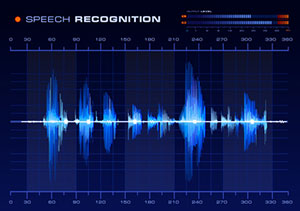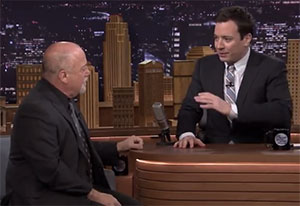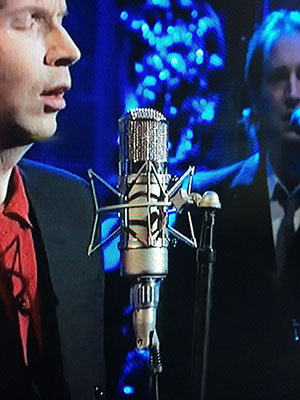 We just finished watching the March 12th episode of CSI, and yet again, it involved something relating to audio recording. Usually it’s some totally impossible “isolating background sound” from a mono recording made on a phone or some other lo-fi device. They always seem to be able to remove everything but the exact sound that will solve the crime. Unless they already know what they are looking for, and have a sample recording of that thing, they wouldn’t be able to subtract the audio that wasn’t that. And even if they did have this sample recording, it’s doubtful they’d get anything very clear or defined. But that isn’t what this particular post is about.
We just finished watching the March 12th episode of CSI, and yet again, it involved something relating to audio recording. Usually it’s some totally impossible “isolating background sound” from a mono recording made on a phone or some other lo-fi device. They always seem to be able to remove everything but the exact sound that will solve the crime. Unless they already know what they are looking for, and have a sample recording of that thing, they wouldn’t be able to subtract the audio that wasn’t that. And even if they did have this sample recording, it’s doubtful they’d get anything very clear or defined. But that isn’t what this particular post is about.
In the episode, Long Road Home, a character recorded a demo at a studio, and the CSI team bring the audio up on their screen to analyze it. One of the team says, “look at the wave form here.” There was absolutely nothing odd about the audio he was pointing at. And the audio itself was mono. Any kind of commercial recording studio – heck, any kind of ANY kind of studio – would record a song in stereo, not mono. That was the first stupid thing. Then there was the part where they hit a button and magically hear some 2nd person who was singing backup in the studio and “bled” into the lead singers track. So if they were recording multitrack music, why did they mix it down to mono? Never mind that. Trust me when I say there is no way they could have eliminated all the main audio, which was guitar and a male lead vocal, and leave behind the voice of some other mystery person, also a male, who was singing into a different mic and being recorded onto a 2nd track. Gaahh! They also said the microphone was “omnidirectional.” But if you were recording a guitar and lead vocal along with a backup singer, who was supposed to be on a separate track, you would NOT use an omni. It would be exactly the wrong kind of mic to keep the lead somewhat isolated from the background vocalist so you could mix them. You’d use directional mics. Sigh. But I digress…again.
OK. OK. Some of you may be wondering why I say it is not possible, when you can fairly easily remove a lead vocal from some music recordings in order create, say, a karaoke track. In editing software, that is usually called “center-channel extraction.” Wanna know why it is called that? Because in a stereo recording (99.99999999999999999 – are you getting the idea? – 999999% of any commercial music recording since 1970), instruments and vocals and effects are spread across the audio stage from left-to-right. And the lead vocal is always (well, 99.99999% etc.) panned dead-center, which really means it isn’t panned at all. So with a bit of audio manipulation, like folding all the stuff left of center over and on top of the stuff right of center (like an audio taco), and then cutting out the part in the crease, then opening the taco again, you can leave everything but the lead vocal. So it might JUST be possible to hear some other voice that drifted in from left or right. But it would STILL be mixed in with the music, so it would be barely audible over the remaining music and certainly not clear enough for a “voice print match” or whatever other audio nonsense they dabble in on the forensic shows.
But the CSI folks didn’t have a stereo file. It was mono. That basically means that everything is panned dead center, by default. If you tried the trick of folding an audio taco on a mono file – well, you couldn’t fold it because there is no “left-to-right audio field” with mono. There’s only a string of audio up the center. OK, weird metaphor I guess. Maybe a blender is better. If you put a tomato, an onion, and a celery stalk into a blender and whipped it into juice, it would be impossible to “isolate” the onion after the fact, right? You did say “right” didn’t you? OK, that’s sort of what the CSI crew supposedly did.
Don’t you just love posts that get my inner audio geek all revved up? The bottom line is that you should not get your knowledge of audio recording and editing from CSI. Home Brew Audio is a much better bet;).
Archives for March 2014
Sing Harmony Like Billy Joel And Jimmy Fallon
 On last night’s Tonight Show, Jimmy Fallon had one of my all-time favorite singers – Billy Joel – on the show. They did something really, REALLY cool. They used an iPad looping app to create a 4-part harmony doo-wop group with just the 2 of them right there at the desk. See the video below.
On last night’s Tonight Show, Jimmy Fallon had one of my all-time favorite singers – Billy Joel – on the show. They did something really, REALLY cool. They used an iPad looping app to create a 4-part harmony doo-wop group with just the 2 of them right there at the desk. See the video below.
I’ve been showing people how to sing harmony with themselves since I started this site. In fact, the desire to sing harmony with myself is the reason I became a recording engineer in the first place!
I demonstrate how awesome this can be on the Harmony Experiments page here: https://www.homebrewaudio.com/vocal-harmony-experiments/
But back to Billy and Jimmy. What they did was use a looping app, which Jimmy Fallon mistakenly called “The Looper.” It was actually the app called “Loopy HD.” The way it works is that you record a short piece of music or a short beat, and the app lays it back over and over again until you tell it to stop. Playing the same short piece of audio or video continuously, over and over again is called “looping,” hence the name of the app. Then while the first loop plays back, you layer a 2nd loop over it (yes, like overdubbing), like a harmony.
The main difference between what Billy and Jimmy did, and what I do, is that I don’t have a time limit on my tracks. Nor do I have to set a loop time (when using Loopy, or any looping program, you have to set a loop time and all parts have to be the same duration or they wouldn’t stay together). That’s mainly because I’m not using looping at all with my harmonies. I simply record one track. Then I start a 2nd track and sing along with the 1st. Rinse and repeat. Billy and Jimmy used about a 10-second loop, enough time to record 4 bars of the “wimoweh” part of the song “the Lion Sleeps Tonight. Check it out below:
If you have an iPhone or iPad (it works on both), you can download the app for $7.99 and start playing with it right away. It’s amazingly fun. And of course you can do more than just be your own doo-wop group. You can use it for beat-boxing, singing, practicing lead guitar parts (by repeatedly having the rhythm part playing over and over again), or any cool thing you can think of.
The first time I saw someone use a looper (though this was before the iPad) in a solo live musical performance was KT Tunstall doing “Black Horse and the Cherry Tree” on The Today Show. It was just her, a guitar, and a “stomp-pedal” looper. She started out by recording her muted guitar strings for rhythm. Then while that was looping, she sang “woo-hoo.” Then while the guitar beat and the first “woo-hoo” were playing, she layered the harmony “woo-hoo” part. As soon as those 3 things were going, she just sang the song with her own 3 loops as her backup band! Pretty amazing stuff. The recording of the loops was part of the performance and took up only about 30 seconds before starting into the song itself.
Anyway, now you see the potential for hours of addictive fun using loops! Enjoy – but do not annoy your family and friends;).
What Microphone Did Beck Use On Saturday Night Live?
 When Beck sang “Wave” on SNL last night (Mar 1st, 2014), he did something unusual. He sang into a large diaphragm condenser (LDC) microphone for a live performance. These mics are typically used only for recording – usually vocals. Singers usually use dynamic microphones for performing live, as Beck did on his first song, “Blue Moon,” a Heil Sound PR 35.
When Beck sang “Wave” on SNL last night (Mar 1st, 2014), he did something unusual. He sang into a large diaphragm condenser (LDC) microphone for a live performance. These mics are typically used only for recording – usually vocals. Singers usually use dynamic microphones for performing live, as Beck did on his first song, “Blue Moon,” a Heil Sound PR 35.
But on “Wave,” Beck sang into a large diaphragm condenser tube microphone called the Telefunken U47/U48, which is a fabulous microphone, used in the studio by some of the greatest acts of all time such as The Beatles and Frank Sinatra, just to name a few.
The main reason that large diaphragm condenser mics are normally only used in the studio is that they are incredibly sensitive, not only in how they pick up sound, but also in how stage-rugged they are not. That last point is significant because this microphone is quite a bit more expensive than typical live dynamic mics like the Heil. You do sometimes see them used in the movies or music videos because they look cool. But for actual live performance, it is most definitely NOT normal to see this.
To find out more about this famous and awesome microphone – or to purchase one of your own – CLICK HERE